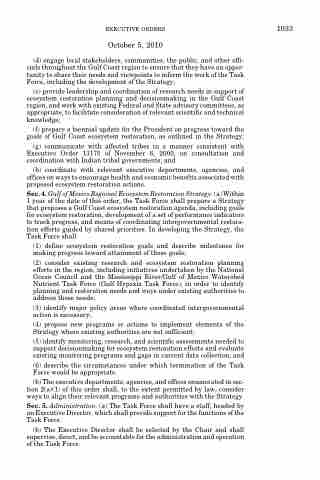Page 1043 - Demo
P. 1043
EXECUTIVE ORDERS 1033 October 5, 2010
(d) engage local stakeholders, communities, the public, and other offi- cials throughout the Gulf Coast region to ensure that they have an oppor- tunity to share their needs and viewpoints to inform the work of the Task Force, including the development of the Strategy;
(e) provide leadership and coordination of research needs in support of ecosystem restoration planning and decisionmaking in the Gulf Coast region, and work with existing Federal and State advisory committees, as appropriate, to facilitate consideration of relevant scientific and technical knowledge;
(f) prepare a biennial update for the President on progress toward the goals of Gulf Coast ecosystem restoration, as outlined in the Strategy;
(g) communicate with affected tribes in a manner consistent with Executive Order 13175 of November 6, 2000, on consultation and coordination with Indian tribal governments; and
(h) coordinate with relevant executive departments, agencies, and offices on ways to encourage health and economic benefits associated with proposed ecosystem restoration actions.
Sec. 4. Gulf of Mexico Regional Ecosystem Restoration Strategy. (a) Within 1 year of the date of this order, the Task Force shall prepare a Strategy that proposes a Gulf Coast ecosystem restoration agenda, including goals for ecosystem restoration, development of a set of performance indicators to track progress, and means of coordinating intergovernmental restora- tion efforts guided by shared priorities. In developing the Strategy, the Task Force shall:
(1) define ecosystem restoration goals and describe milestones for making progress toward attainment of those goals;
(2) consider existing research and ecosystem restoration planning efforts in the region, including initiatives undertaken by the National Ocean Council and the Mississippi River/Gulf of Mexico Watershed Nutrient Task Force (Gulf Hypoxia Task Force), in order to identify planning and restoration needs and ways under existing authorities to address those needs;
(3) identify major policy areas where coordinated intergovernmental action is necessary;
(4) propose new programs or actions to implement elements of the Strategy where existing authorities are not sufficient;
(5) identify monitoring, research, and scientific assessments needed to support decisionmaking for ecosystem restoration efforts and evaluate existing monitoring programs and gaps in current data collection; and
(6) describe the circumstances under which termination of the Task Force would be appropriate.
(b) The executive departments, agencies, and offices enumerated in sec- tion 2(a)(1) of this order shall, to the extent permitted by law, consider ways to align their relevant programs and authorities with the Strategy.
Sec. 5. Administration. (a) The Task Force shall have a staff, headed by an Executive Director, which shall provide support for the functions of the Task Force.
(b) The Executive Director shall be selected by the Chair and shall supervise, direct, and be accountable for the administration and operation of the Task Force.


